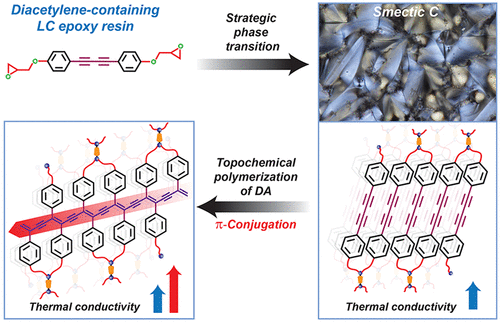当前位置:
X-MOL 学术
›
Macromolecules
›
论文详情
Our official English website, www.x-mol.net, welcomes your
feedback! (Note: you will need to create a separate account there.)
Diacetylene-Containing Dual-Functional Liquid Crystal Epoxy Resin: Strategic Phase Control for Topochemical Polymerization of Diacetylenes and Thermal Conductivity Enhancement
Macromolecules ( IF 5.1 ) Pub Date : 2022-05-04 , DOI: 10.1021/acs.macromol.2c00436
Md. Monir Hossain 1, 2 , Arinola Isa Olamilekan 3 , Hyun-Oh Jeong 1 , Hongjin Lim 1 , Young-Kyeong Kim 1, 4 , Hyunjin Cho 1 , Hyeon Dam Jeong 1 , Md. Akherul Islam 2 , Munju Goh 5 , Nam-Ho You 6 , Myung Jong Kim 7 , Siyoung Q. Choi 4 , Jae Ryang Hahn 2 , Hyeonuk Yeo 3, 8 , Se Gyu Jang 1
Macromolecules ( IF 5.1 ) Pub Date : 2022-05-04 , DOI: 10.1021/acs.macromol.2c00436
Md. Monir Hossain 1, 2 , Arinola Isa Olamilekan 3 , Hyun-Oh Jeong 1 , Hongjin Lim 1 , Young-Kyeong Kim 1, 4 , Hyunjin Cho 1 , Hyeon Dam Jeong 1 , Md. Akherul Islam 2 , Munju Goh 5 , Nam-Ho You 6 , Myung Jong Kim 7 , Siyoung Q. Choi 4 , Jae Ryang Hahn 2 , Hyeonuk Yeo 3, 8 , Se Gyu Jang 1
Affiliation

|
Liquid crystal epoxy resins (LCERs) with high thermal conductivity have been drawing significant attention to overcome the thermal conductivity limitation of polymeric composites. Nonetheless, the strategy to enhance the thermal conductivity of LCERs has been primarily focused on improving the well-ordered molecular structure originated from LC phases to reduce phonon scattering. Furthermore, other important factors for the enhancement of thermal conductivity such as intermolecular interaction, fine-tuning of the polymer chain structure, and interchain conjugation have been rarely investigated for LCERs. Here, we introduce a dual-functional LCER enabling the creation of well-ordered microstructures as well as intermolecular π-conjugation networks synergistically suppressing the phonon scattering. As a key design functional group, the diphenyl-diacetylene (DPDA) mesogen was employed to assemble a highly ordered lamellar microstructure and create interchain π-conjugation networks via topochemical polymerization of well-organized diacetylenes. The thermal conductivity of cured DPDA epoxy resin with a highly ordered lamellar structure (∼0.43 W m–1 K–1) was 194% compared to a commercial epoxy resin (∼0.22 W m–1 K–1). Thermal conductivity was further increased up to 227% (∼0.50 W m–1 K–1) via post-topochemical polymerization of diacetylenes, leading to π-conjugation and interchain π–π stacking. Furthermore, the thermal conductivity of the composites prepared with hexagonal boron nitride fillers was also increased by 19% after simple heat treatment of the composites, inducing topochemical polymerization of diacetylenes. Finally, a striking thermal conductivity increase from 10.3 W m–1 K–1 to 18.3 W m–1 K–1 was observed by simply replacing the matrix from the commercial one to DPDA epoxy resin (DPDAER), clearly revealing the superiority of our DPDAER in the development of high-thermal-conductivity composites.
中文翻译:

含二乙炔的双功能液晶环氧树脂:二乙炔拓扑化学聚合和导热性增强的战略相位控制
具有高热导率的液晶环氧树脂(LCER)已引起人们的极大关注,以克服聚合物复合材料的热导率限制。尽管如此,提高 LCER 热导率的策略主要集中在改善源自 LC 相的有序分子结构以减少声子散射。此外,对于 LCER,很少研究提高热导率的其他重要因素,例如分子间相互作用、聚合物链结构的微调和链间共轭。在这里,我们介绍了一种双功能 LCER,能够创建有序的微结构以及协同抑制声子散射的分子间 π 共轭网络。作为一个关键的设计功能组,使用二苯基-二乙炔(DPDA)介晶组装高度有序的层状微结构,并通过组织良好的二乙炔的拓扑化学聚合形成链间π-共轭网络。具有高度有序层状结构的固化 DPDA 环氧树脂的热导率 (~0.43 W m–1 K –1 ) 与商业环氧树脂 (~0.22 W m –1 K –1 ) 相比是 194%。通过二乙炔的后拓扑化学聚合,热导率进一步提高到 227% (~0.50 W m –1 K –1 ),导致 π-共轭和链间 π-π 堆积。此外,用六方氮化硼填料制备的复合材料的热导率在复合材料的简单热处理后也增加了 19%,从而引发了联乙炔的拓扑化学聚合。最后,热导率从 10.3 W m –1 K –1显着增加至 18.3 W m –1 K –1通过简单地将基质从商业基质替换为 DPDA 环氧树脂 (DPDAER) 就可以观察到,这清楚地揭示了我们的 DPDAER 在开发高导热复合材料方面的优越性。
更新日期:2022-05-04
中文翻译:

含二乙炔的双功能液晶环氧树脂:二乙炔拓扑化学聚合和导热性增强的战略相位控制
具有高热导率的液晶环氧树脂(LCER)已引起人们的极大关注,以克服聚合物复合材料的热导率限制。尽管如此,提高 LCER 热导率的策略主要集中在改善源自 LC 相的有序分子结构以减少声子散射。此外,对于 LCER,很少研究提高热导率的其他重要因素,例如分子间相互作用、聚合物链结构的微调和链间共轭。在这里,我们介绍了一种双功能 LCER,能够创建有序的微结构以及协同抑制声子散射的分子间 π 共轭网络。作为一个关键的设计功能组,使用二苯基-二乙炔(DPDA)介晶组装高度有序的层状微结构,并通过组织良好的二乙炔的拓扑化学聚合形成链间π-共轭网络。具有高度有序层状结构的固化 DPDA 环氧树脂的热导率 (~0.43 W m–1 K –1 ) 与商业环氧树脂 (~0.22 W m –1 K –1 ) 相比是 194%。通过二乙炔的后拓扑化学聚合,热导率进一步提高到 227% (~0.50 W m –1 K –1 ),导致 π-共轭和链间 π-π 堆积。此外,用六方氮化硼填料制备的复合材料的热导率在复合材料的简单热处理后也增加了 19%,从而引发了联乙炔的拓扑化学聚合。最后,热导率从 10.3 W m –1 K –1显着增加至 18.3 W m –1 K –1通过简单地将基质从商业基质替换为 DPDA 环氧树脂 (DPDAER) 就可以观察到,这清楚地揭示了我们的 DPDAER 在开发高导热复合材料方面的优越性。































 京公网安备 11010802027423号
京公网安备 11010802027423号